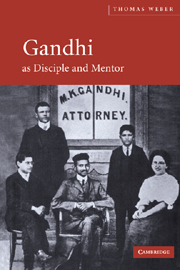Book contents
- Frontmatter
- Contents
- Notes
- Preface
- Glossary
- PART I INFLUENCE
- PART II GANDHI INFLUENCED
- 2 The influenced Gandhi
- 3 Henry Polak and the setting up of Phoenix Settlement
- 4 Hermann Kallenbach and the move to Tolstoy Farm
- 5 Maganlal Gandhi and the decision to leave Sabarmati
- 6 Jamnalal Bajaj and the move to Sevagram
- 7 The top of the hourglass: Gandhi influenced
- PART III GANDHI'S INFLUENCE
- Bibliography
- Index
6 - Jamnalal Bajaj and the move to Sevagram
Published online by Cambridge University Press: 22 September 2009
- Frontmatter
- Contents
- Notes
- Preface
- Glossary
- PART I INFLUENCE
- PART II GANDHI INFLUENCED
- 2 The influenced Gandhi
- 3 Henry Polak and the setting up of Phoenix Settlement
- 4 Hermann Kallenbach and the move to Tolstoy Farm
- 5 Maganlal Gandhi and the decision to leave Sabarmati
- 6 Jamnalal Bajaj and the move to Sevagram
- 7 The top of the hourglass: Gandhi influenced
- PART III GANDHI'S INFLUENCE
- Bibliography
- Index
Summary
INTRODUCTION
After having left Sabarmati, the political campaign of the Civil Disobedience movement launched by the Salt March behind him, it was not by accident that Gandhi set up his next and last ashram in a small village not far from the town of Wardha, in the geographical centre of India. Before settling (as much as the Mahatma was ever able to settle anywhere) by the side of Segaon village, Gandhi lived for a while with some of his erstwhile ashramites in Wardha at the branch Satyagraha Ashram which had been set up by his spiritual heir Vinoba Bhave, and then with a group of followers at a large house with extensive orange orchards which had been donated to him by Jamnalal Bajaj. The property was named Maganwadi in memory of Maganlal Gandhi. But why is it that Vinoba had gone to Wardha in the first place? And why did Gandhi also end up there – was it as simple as Vinoba's presence? Was it the gift of property from Bajaj when presumably Gandhi could have chosen any part of India and received as much property as he needed? Was there something special about Wardha which attracted both Vinoba and Gandhi? Surely it was not the healthy climate, as the malaria-ridden Wardha district is one of the hottest areas of India. The influence of Jamnalal Bajaj, the constructive worker, spiritual seeker and Gandhi's adopted son, is the key.
- Type
- Chapter
- Information
- Gandhi as Disciple and Mentor , pp. 102 - 119Publisher: Cambridge University PressPrint publication year: 2004

